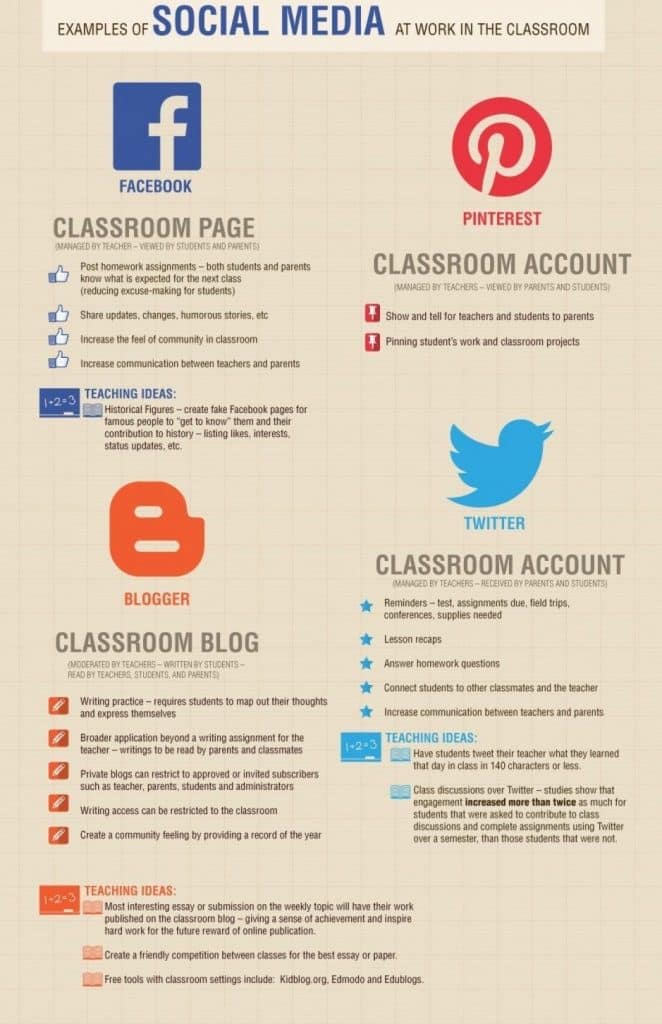
Wonderlane / Unsplash
Today, more and more schools are discovering ways to use social media to meet multiple goals. Learning institutions are turning to their social channels to spread information faster, create and nurture a sense of community, and generate awareness on course offerings and campaigns. This article gives you a glimpse of the social media landscape as it pertains to the education sector and provides tips on how you can boost your brand through the platform.
Table of Contents
Benefits of Social Media on the Education Sector
Social media offers schools and teachers ways to facilitate learning and capture students’ interest. Because many students, as well as their parents, are already on social media and quite adept at using the platform, educators who maximize social media are able to bring the classroom closer to their pupils and their guardians.
For example, teachers can create Facebook groups dedicated to posting homework and important announcements. They can also use Pinterest to display students’ artwork and projects. These accounts can be accessible not just to students but also to parents. That way, parents can stay updated on their children’s schooling and interact with teachers and other parents.

Source: Elearninginfographics.com
Key Statistics on Social Media and Education
Below are a few statistics to show social media’s reach among teens and U.S. adults.
- The majority of adults in the U.S., regardless of educational background, are on social media. Also, more than three-quarters of individuals who finished college are on social networks.
- 96% of students with internet access are using social media.
- Among 7th to 12th graders, 75 percent have a social media profile.
- More than half (73 percent) of 13- to 17-year-olds are checking social media at least daily.

Source: Common Sense Education
Given social media’s popularity among the school-age population and adults, educational institutions that maximize these platforms can potentially reach a much broader population.
Crafting an Effective Social Media Strategy for the Education Sector
Learning institutions can use social media networks for a broad range of goals, from getting more leads to providing better support to spreading word about important achievements and events. Below are tips to help your school create an effective social media strategy.
1. Set Measurable Goals
Develop specific measurable goals for what you want to achieve through your social media campaign. For instance, if you’re hoping to generate leads, specify how many leads you want to have within a specific time period. If you’re unsure where to start, below are some common social media goals you can adapt for your school.

Source: Hootsuite
Next, do a social media audit to identify where you are versus where you want to go. List down all the social media accounts you have. Look at your social media analytics to understand the level of engagement you’re getting on each platform.
Be sure to gather data related to the goals you’ve set. If you want to increase leads, find out how many leads you’ve generated through your social networking sites in the past months. This will serve as your baseline data and help you determine whether or not your social media strategies are working.
After determining where you are, study your competitors’ online strategy. Find out what keywords they’re using and which channels they’re on. Determine the types of content they’re publishing on their accounts and which of these generate the most likes, shares, and comments.
2. Prepare a Social Media Style Guide
Whether you work for a small school or a university, taking time to organize a style guide will generate multiple benefits for your institution. Here are a few:
- Consistency: You are able to use a consistent tone and voice in your published posts, which then contributes to the strength of your brand image.
- Coordination: This is especially important if you have several staff handling social media management or your departments are maintaining their own social accounts. Having a guide keeps everyone on the same page on what to do, what to avoid, and how to engage with users.
- Maintaining quality: Clarifying posting standards empowers your departments to maintain the quality of published posts.
Here are some items to include as you create or improve your school’s style guide:
- Official social media profiles
- Naming conventions
- Guidelines for profile information, cover, and header images
- Brand colors
- Hashtags
- Rules for images, graphics, video posts, and user-generated content
- Handling comments, inquiries, and competitor interactions
- Guides for each social media network
- Post format
- Crediting sources
3. Choose Appropriate Platforms for Your Campaigns
Social media channels have different user demographics. Before launching your campaign, consider the networks your target audience is more likely to use. For example, if you want to increase awareness about a new postgraduate course, focus on channels your ideal enrollees may be using often. If you’re targeting professionals, consider advertising on LinkedIn, scheduling related posts on your school’s alumni pages, or crafting a Facebook marketing strategy, targeting individuals with related interests.
4. Incorporate Live Streaming and Student-Generated Content
Providing users with different ways to engage with your school can increase awareness of your programs and nurture a sense of community while adding more traffic to your social media channels.
Live streaming, for instance, allows potential students and their parents to glimpse campus life. Meanwhile, streaming-specific events allow parents, students, and alumni who cannot be physically present during these activities to participate and stay updated no matter where they may be.
Allowing student-generated content and stories diversify your social media posts. Potential enrollees may find these posts more relatable, allowing them to see themselves being in your school. Featuring students may also increase traffic to your accounts, as these individuals and their families or friends may share these posts to their contacts.
5. Diversify Your Social Media Posts
Variety drives engagement. When creating your content calendar, go beyond words and images. Include video clips, newsletters, user-generated content, or even virtual tours. You can also add interactive content, such as quizzes, polls, and contests.
6. Be Responsive
Having an active social media presence goes beyond publishing posts regularly. To keep people engaged, you need to make sure your teams are responding to comments and inquiries in a timely manner. Being swift is especially essential for managing negative comments and false information that can hurt your school’s reputation.
7. Provide Career-Planning Resources
Students are often at a loss when it comes to what they want to do or who they wish to be. Learning institutions can take advantage of social media to provide more guidance to current students, prospective enrollees, and even alumni who may want to explore other careers.
Schools can use social media to share information on high-demand skills in specific industries. They can also provide more resources on different careers as they relate to specific college courses or learning tracks.
8. Use Data to Improve Your Strategies
Social media campaigns don’t end with implementing strategies. You need to know whether you’ve achieved, or even exceeded, the goals you’ve set.
There is so much you can learn from your social media analytics, such as the types of posts that generated the highest shares and reactions. Knowing this information can help you improve future campaigns by doing more of what worked and focusing your resources on platforms that generated the highest results.
Making Social Media Work for Educational Institutions
Social media channels have provided schools with additional avenues for connecting with students, parents, and alumni and showcasing what they have to offer. Nurturing these relationships, in turn, helps maintain and strengthen their loyalty to their alma mater.
For these reasons, schools and educators must continuously improve their social media strategy and treat it as an essential component of their promotions and communication plans.
